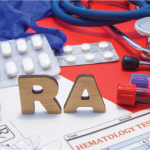NEW YORK (Reuters Health)—The combination of methotrexate, sulphasalazine and hydroxychloroquine is similar in effect as methotrexate plus biologic therapy for patients with rheumatoid arthritis (RA), according to a new network meta-analysis.
“Thus, for most patients, this low-cost combination of medications should probably be tried before moving onto biologic therapy, either as initial treatment or as a step-up treatment in patients who don’t respond well to initial treatment with methotrexate alone,” Dr. Glen Hazlewood of the University of Calgary, Alberta, Canada, told Reuters Health by email.
Dr. Hazlewood and colleagues conducted a systematic review and network meta-analysis of published trials, meeting abstracts, two trial registers and Cochrane reviews. They extracted ACR50 response data, plus data on radiographic progression and treatment withdrawals due to adverse events. Of the 158 trials included, between 10 and 53 had data for each outcome.
Overall, the team found that methotrexate triple therapy and most regimens of biologic disease-modifying antirheumatic drugs (DMARDs) effectively controlled disease activity and were well tolerated in methotrexate-naive and methotrexate-exposed patients, they report in an article online on April 21 in The BMJ.
Several treatments, including triple therapy, turned out to be statistically superior to oral methotrexate alone for ACR50 response in methotrexate-naïve patients, with the probability of ACR50 response similar among the treatments at 56%–67% compared with 41% for methotrexate alone.
Methotrexate combined with adalimumab, etanercept, certolizumab or infliximab was statistically superior to oral methotrexate for inhibiting radiographic progression, but the change over one year was “less than minimal clinically important,” the researchers write.
Triple therapy produced statistically fewer treatment withdrawals due to adverse events than methotrexate plus infliximab.
For methotrexate-exposed patients, the researchers found several treatments, including triple therapy, were statistically superior to oral methotrexate for ACR50 response, with the probability of response at 61% for triple therapy and ranging from 27% to 70% for other therapies.
They found no statistically significant differences for these patients between any treatment and oral methotrexate for radiographic progression. The only treatments that had significantly higher rates of withdrawal due to adverse events were methotrexate plus cyclosporine and methotrexate plus tocilizumab 8 mg/kg.
“As triple therapy costs 10-20 times less than biologic therapy and is not currently recommended strongly by international guidelines, this has important policy implications. Specifically, our results suggest that triple therapy should be considered as a low cost, effective treatment option either as initial treatment or after an inadequate response to methotrexate,” the researchers concluded.
“Many patients, particularly in the U.S., proceed to biologic therapy after failure of methotrexate alone. Our review challenges this approach,” Dr. Hazlewood told Reuters Health.
“Any systematic review summarizes average treatment effects,” he continued. “These choices are often complex and need to be tailored to a patients’ disease activity and preferences. This should occur through a shared discussion with the patient and his or her rheumatologist.”
The Arthur J.E. Child chair in rheumatology outcomes research partially supported this research.

